Planning the first page of a sketchbook can feel intense, almost like meeting a dragon on your first day of school. Start strong by setting a goal—maybe a funny quote, a simple doodle, or a favorite theme like robots or snacks. Don’t stress about perfection; quick sketches and bursts of color add energy. Mix in your thoughts or a quirky marker. This first page isn’t just paper; it’s the gateway to all your creative adventures. Want the secrets to really making it pop?
Key Takeaways
- Set your creative intentions by writing a goal, quote, or personal statement to give purpose and reduce first-page anxiety.
- Choose a theme or focus to guide your sketches and establish a cohesive direction for your sketchbook journey.
- Explore different layout options, such as zones, centerpieces, or thumbnails, to organize the page and spark excitement.
- Combine simple images, text, and color accents to create visual interest and personalize your opening page.
- Include personal touches, such as doodles or listed goals, to make the first page meaningful and motivate your creative progress.
Setting Your Creative Intentions
Why does the first page of a sketchbook feel so important, anyway? Maybe it’s because that first step is where the creative journey really begins—it’s personal, like announcing, “Hey world, this is me and my art!”
Before touching pen to paper, artists often take a minute to set their creative intentions. Some people dream up goals, like mastering shading or simply recording their daily experiences, so every sketchbook page feels like a milestone.
Others pick a theme—like animals, food, or even wild robots—which brings some order to the creativity. It helps to remember the sketchbook is a safe place for mistakes, experiments, or goofy doodles.
Opening with a motivational quote or personal statement can set a positive tone that echoes throughout the book.
Overcoming First Page Nerves
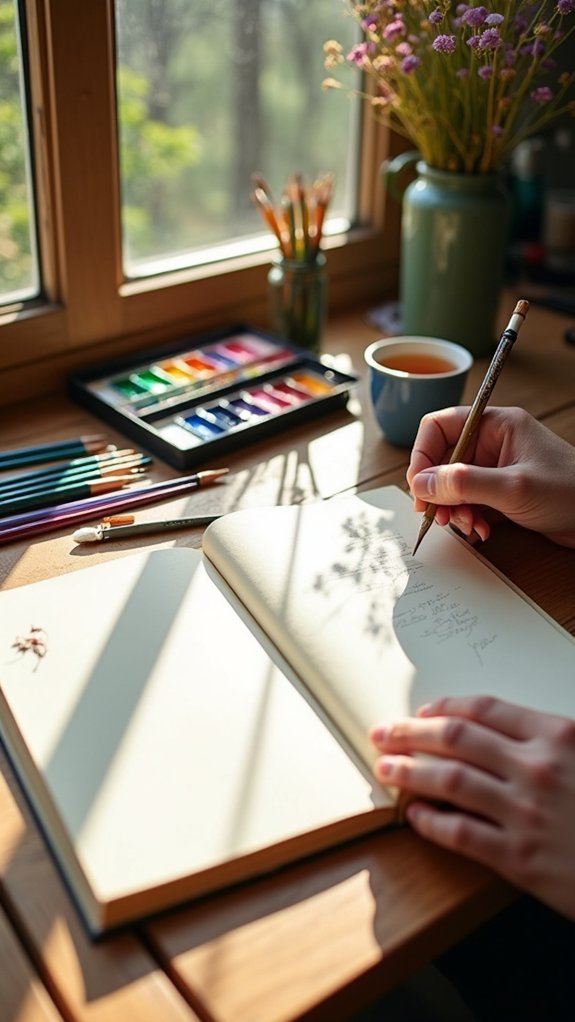
Once all those creative intentions are buzzing in someone’s head, it’s pretty common for the first page to start feeling like a big, scary deal. That blank page can almost dare someone to mess up, which makes it even tougher to begin.
But here’s a secret: the creative process isn’t about perfection—it’s about experimenting and having fun. If someone wants to shake off that pressure, they can try these tricks:
- Give yourself permission to make mistakes; nobody’s judging those wild scribbles.
- Start with easy, no-stress doodles or silly line patterns to warm up.
- Remember, your purpose matters way more than a flawless first page.
- If that first page feels too intimidating, fill the first page last, and let the creativity flow elsewhere first!
Choosing a Theme or Focus
Even if picking a theme sounds like something only super-organized artists do, it can actually be the magic spark for any sketchbook. Choosing a theme or a focus gives your artistic journey some direction, like a treasure map for your sketches. Want to sketch birds, robots, or just your left shoe a hundred times? It’s your world! A clear theme helps your ideas connect and makes flipping through your sketchbook feel like reading an adventure story.
| Theme Idea | Possible Focus |
|---|---|
| Nature | Trees, leaves, sunlight |
| Urban Life | Buildings, people, street |
| Dreams | Surreal scenes, fantasy |
| Everyday Things | Shoes, mugs, headphones |
Reflecting on your chosen theme as you create can lead to real artistic growth—and who knows what you’ll discover next!
Exploring Layout Possibilities
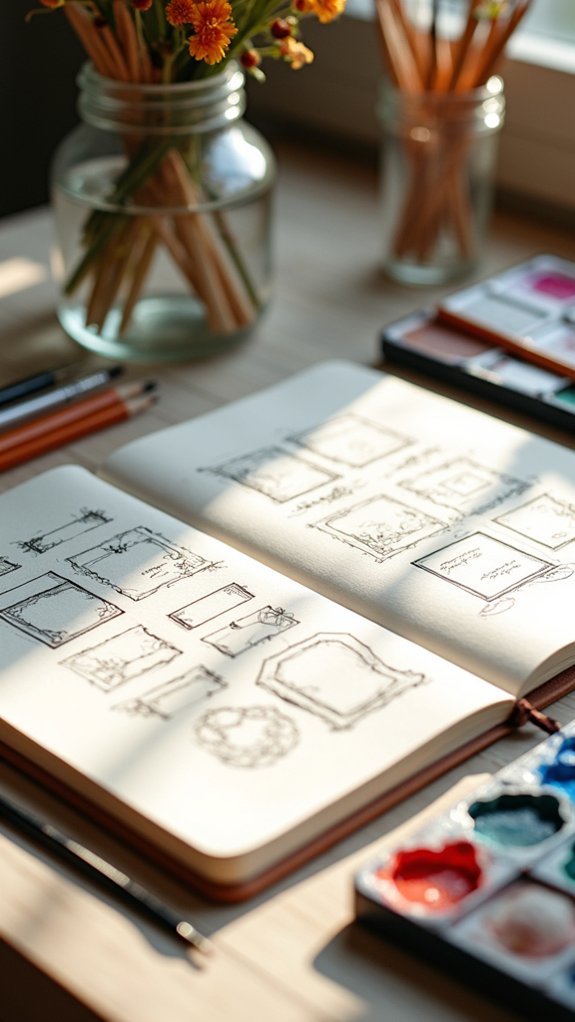
Although staring at that blank opening page can feel a bit like standing at the edge of a diving board, choosing a layout can turn nerves into excitement.
There are more layout possibilities than pizza toppings—seriously! It’s all about mixing things up and having fun while planning the arrangement of your sketches.
Whether you want something wild or super chill, thinking about composition really helps organize your thoughts and your art.
Here are four ways to kickstart your opening page:
- Split the page into rectangles, creating zones for different sketches and ideas.
- Place a powerful sketch right in the center, arranging smaller sketches around it for a centerpiece vibe.
- Use dashes of color to connect parts of your page and grab attention.
- Test out arrangements with tiny thumbnail sketches before settling.
Mixing Images and Text
When planning your sketchbook’s first page, mixing words and pictures can really make things pop. Jotting down notes, thoughts, or funny captions right next to your drawings helps balance visuals with writing and gives each piece extra meaning—sometimes a doodle just wants to say something!
Smart annotations don’t just explain what’s happening; they let your viewers in on secrets, backstories, or even the artist’s blunders, which makes flipping the page way more fun.
Balancing Visuals With Writing
Mixing pictures with words can turn a simple sketchbook page into something way more exciting and personal.
It’s not just about showing off your art or your writing—when you blend them, your creative ideas come to life in whole new ways. Balancing images and text means thinking about where each belongs so they won’t fight for attention or look awkward.
Here are four key points to remember when making your sketchbook pages pop:
- Place text near images to connect them—don’t let drawings feel lonely!
- Use negative space, so both words and pictures can “breathe,” and nothing gets too crowded.
- Try different fonts or hand lettering to give your work extra flair and energy.
- Bringing in personal reflections or well-chosen quotes adds emotion and makes everything feel more “you.”
Enhancing Meaning Through Annotations
Bringing text and images together isn’t just about making your sketchbook look cool—it’s like adding secret codes and hidden messages that make each page mean so much more. By using annotations, artists can enhance the creative power of their sketches, giving every doodle a deeper narrative. Whether documenting wild thoughts, bits of inspiration, or that weird feeling from last Saturday, writing beside drawings fills in the blanks and boosts personal connection. Play around with different fonts or wild hand lettering—nobody ever said annotations had to be boring! For extra flair, try including your favorite quotes or quirky prompts to tie everything together. Here’s a table of annotation ideas to get you started:
| What to Add | How It Enhances | Creative Twist |
|---|---|---|
| Thoughts & Feelings | Shows emotion | Funky handwriting |
| Quotes/Prompts | Builds narrative | Mix bold/italic styles |
| Observations | Adds context | Use colored pens |
Embracing Color and Decorative Elements
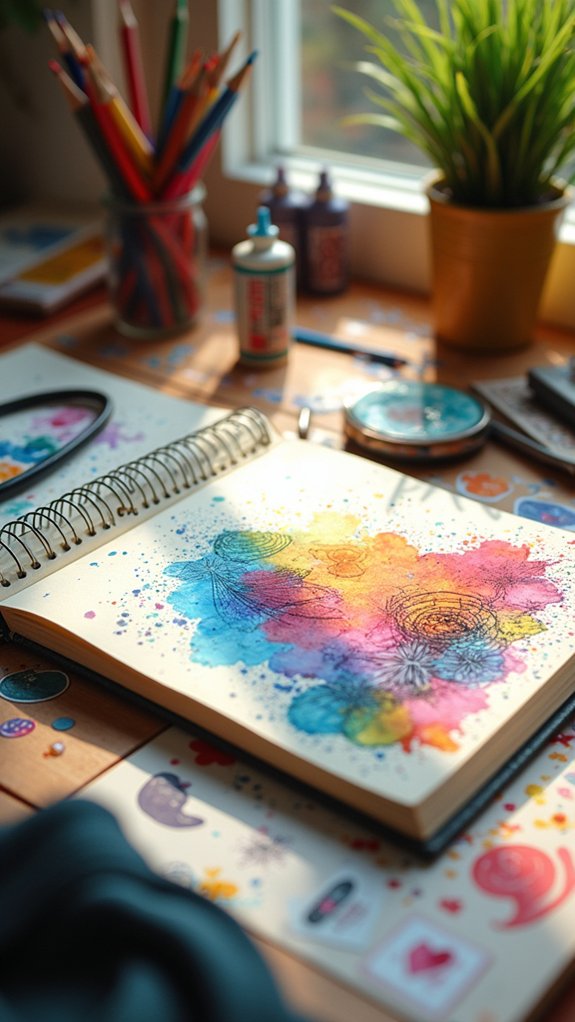
Choosing the right color scheme can totally make your opening page pop, setting the mood and showing off your style from the very start.
Decorative borders aren’t just fancy—they frame your artwork and can even make smudges look stylish (trust us, it happens to everyone).
Splashing in color accents here and there keeps things lively, like sprinkles on a cupcake, drawing attention and giving the whole page some serious personality.
Selecting a Color Scheme
Gathering the right splash of color at the very start can set the mood for the whole sketchbook—kind of like picking the opening song for a playlist.
A well-chosen color scheme instantly adds energy and shows off personal style. Limiting the palette to 2-4 colors keeps everything harmonious (and stops things from getting wild and messy).
It’s about using color placement, decorative elements, and smart color choices to boost visual interest and welcome anyone who opens the book.
- Pick colors that express your mood or theme; keep it simple—just 2-4 shades.
- Use complementary colors for contrast, helping important parts pop.
- Place color strategically—think about what you want to draw attention to.
- Play with patterns or little textures in your chosen colors for personality!
Adding Decorative Borders
Even though borders might sound like just a finishing touch, they actually have the power to totally level up the first page of a sketchbook.
Decorative borders grab attention right away, framing your art like it’s ready to walk a red carpet. They boost visual appeal, making everything look more put together.
Think about trying out different designs—maybe sharp geometric patterns or wavy, organic shapes—to show off your personal aesthetic.
Want to add some extra interest? Play with line weights, or swap between thin, delicate edges and thick, bold lines.
When you use a consistent design for borders throughout your sketchbook, it’s like a secret handshake for your style—people will spot your vibe instantly.
Integrating Color Accents
A splash of color can totally transform that intimidating first blank page into something bold and unforgettable.
Even just a few color accents can steer the eye, create excitement, and break that “where do I start?” pressure. Picking a color palette that fits the sketchbook’s overall vibe keeps things looking cool and organized.
Want to turn things up a notch? Try these ideas:
- Try out contrasting colors to make important words or drawings absolutely pop.
- Use gradients to give backgrounds a boost of depth and dimension—watch your page come alive.
- Add decorative elements like borders, quirky patterns, or playful doodles for flair.
- Mix different color mediums—think watercolor splashes, colored pencil shading, and marker outlines—for a page packed with texture and surprise.
Color totally sets the mood!
Keeping It Simple: Starting With What You Love
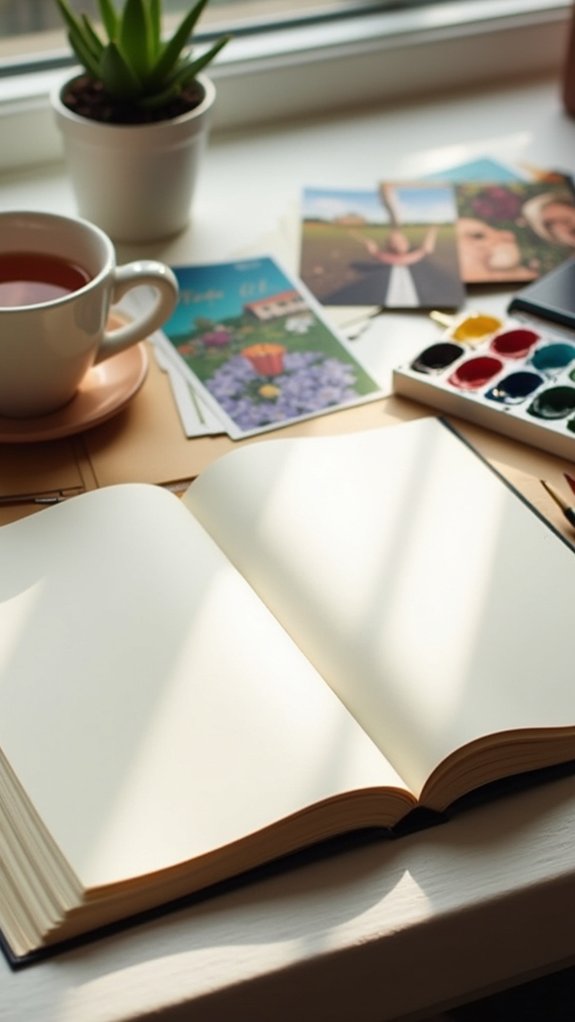
Sometimes the best way to kick off a blank sketchbook page is to forget about fancy techniques and just jump in with something you truly love. Whether that’s sketching your favorite animal, doodling a scene from your favorite movie, or showing off your personal interests, starting simple can take a lot of the pressure off. A simple layout—like a big, bold rectangle or even just a centered doodle—can make your page look neat and pulled together. Want to stand out? Add a splash of color to highlight your work, but don’t feel like you need to fill every inch. Pop in a meaningful quote for a burst of inspiration and personality that greets you every time you open your sketchbook!
| Idea | Simple Layout | Color Accent |
|---|---|---|
| Favorite animal | Centered drawing | Blue highlight |
| Movie scene | Rectangle frame | Yellow border |
| Positive quote | Banner at the top | Red underline |
Building Habits Through Your First Page
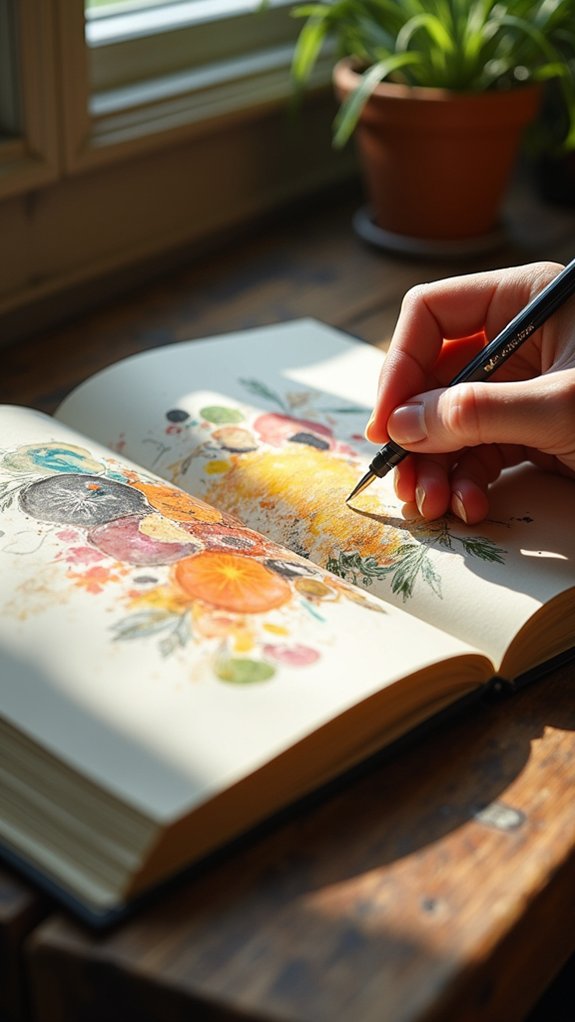
While the first blank page of a new sketchbook can feel like a boss fight staring you down, setting up a few easy habits from the start can help take the pressure off and make the whole thing way more fun.
A creative sketchbook isn’t only about what you draw; it’s about building habits that turn a boring notebook into a sketchbook journey filled with images, ideas, and maybe a few awkward doodles.
Try these four steps:
- Set a loose theme or goal for your sketchbook to guide you (but don’t overthink it).
- Save the first page for last. Jump in and let your sketches flow right away.
- Do a 10-minute warmup: quick sketches or goofy doodles, just to break the ice.
- Make a sketching ideas list for days when inspiration hides under the bed.
Adding Personal Touches and Goals
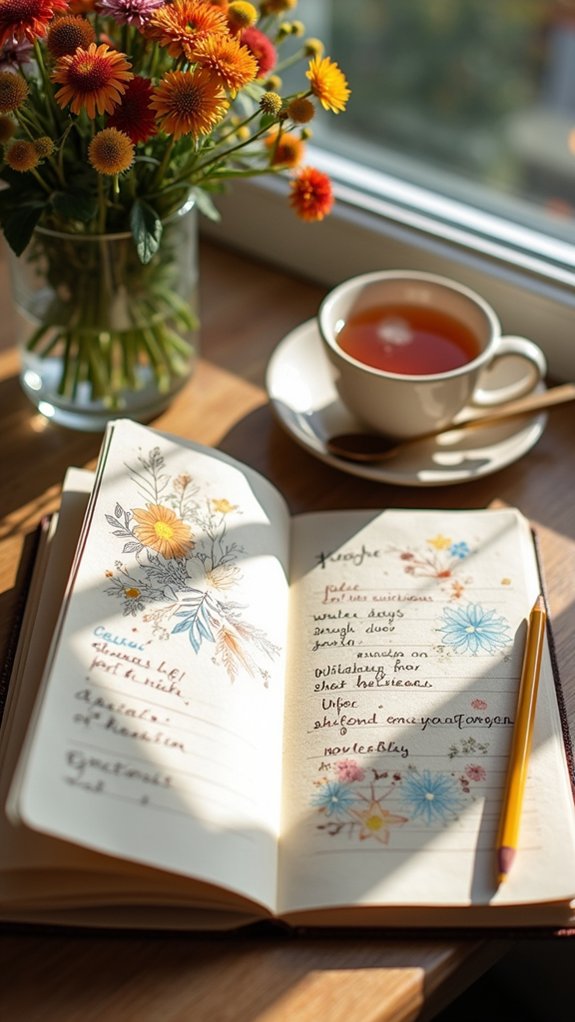
The first page is a great spot to plant your creative flag and show what you’re all about, so why not make it completely yours?
By setting clear intentions and sprinkling in special touches—like a favorite quote, a doodle that feels super “you,” or even a few wild color swatches—artists can really kick things off with energy.
Adding these details not only sets the mood, but also keeps those big goals in sight every time the book is opened.
Setting Creative Intentions
Creative intention brings a special kind of magic to the opening page of any sketchbook—like drawing a bold line that says, “This is where my journey begins!”
By adding personal touches, such as quotes that make someone smile or a quick scribble of goals, artists can make their sketchbooks feel like totally unique treasures.
Setting creative intentions helps guide the whole artistic journey, making it easier to stay focused and motivated.
Here are four ways to use creative intentions for a meaningful connection:
- Write a mission statement about your personal goals for this sketchbook—whether it’s practicing portraits or just having more fun.
- Reflect on past art adventures and lessons learned.
- Add a quote that sparks joy or inspires creativity.
- Start with a doodle or collage representing current interests.
Personalizing With Meaningful Details
A splash of personality on a sketchbook’s first page can turn blank paper into the start of something magical.
Adding personal touches—like doodles or a favorite sticker—makes the book feel truly yours. Why not tape in a tiny photo or ticket stub from a day you want to remember?
Jotting down a meaningful quote or mantra can set the tone and cheer you on when you hit a creative slump. Goals for your sketchbook help, too. Write what you hope to accomplish, whether it’s sketching daily or trying out wild color combinations.
And don’t forget to reflect on your current mindset; a quick note about how you’re feeling can show how much you grow. This opening page is your creative launchpad!
Planning for Progress and Growth
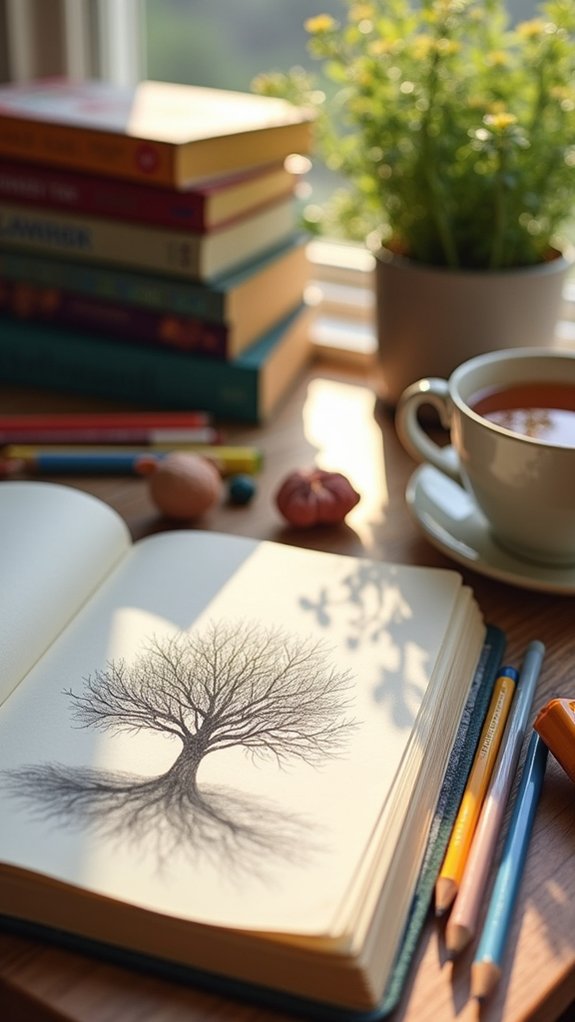
Growth never just happens; it’s something artists actually plan for, even on the first page of a sketchbook.
Think about it—by setting goals, you create a path for progress and creativity. The opening page isn’t just a blank space waiting for doodles; it’s the launchpad for your artistic adventure.
Here are some ways to make your first page count:
- Think about your purpose: Why did you start this sketchbook?
- Set one big goal, or maybe two, that you want to work toward.
- Create a theme to tie your sketches together and spark new ideas.
- Leave space for questions or notes, so you can check your growth later.
Every mark you make is proof of your progress—let it show!
Frequently Asked Questions
How to Design the First Page of Your Sketchbook?
Designing the first page of a sketchbook involves combining creative inspiration, visual elements, and a personal touch. A thematic focus guides content selection, ensuring a balanced, inviting introduction that sets the tone for the pages that follow.
How Should I Start My Sketchbook?
When starting a sketchbook, one should consider inspiration sources, clearly define personal goals, and reflect on their artistic style. Thoughtful theme selection can guide creative exploration, ensuring each page aligns with evolving intentions and artistic development throughout the sketchbook.
How Do I Make My GCSE Art Sketchbook Better?
To improve their GCSE art sketchbook, a student should focus on sketchbook organization, incorporate varied artistic techniques, use creative prompts to spark ideas, and consistently document personal inspiration, resulting in a more engaging and thoughtfully structured portfolio.
What to Write in GCSE Art Sketchbook?
When considering what to write in a GCSE art sketchbook, students should focus on documenting artistic expression, explaining project inspiration, including visual references, and capturing personal reflections to demonstrate creative growth and thoughtful engagement with their artistic process.
Conclusion
Starting a sketchbook can feel scary, but it’s also super exciting—kind of like jumping into a pool and not knowing if the water’s cold or warm. By thinking through themes, layouts, and personal touches, anyone can turn that first blank page into something awesome. Just remember: mistakes are part of the adventure, and your style is totally yours. So, grab your pencil, take a deep breath, and let your creativity boss that first page around!

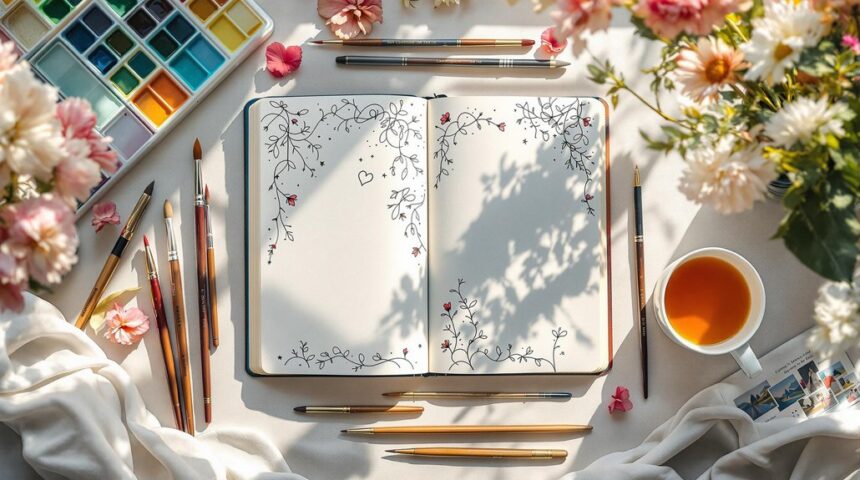
Leave a Reply